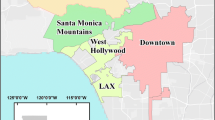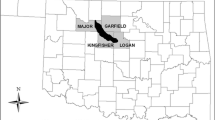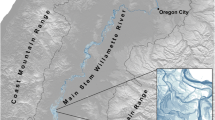Abstract
Irrigation of pasture forms the greatest single use of irrigation water in Australia yet there has been little monitoring of its spatial extent and water demands across southeast Australian coastal catchments where irrigated dairy farming forms an important rural livelihood. This paper provides an analysis of spatio-temporal patterns in the extent of irrigated pasture in the Bega–Bemboka catchment on the south coast of New South Wales from Landsat imagery, and establishes quantile regression relationships between metered monthly irrigation abstraction volumes, evaporation and rainfall. Over the metering period (2000–2007), annual water usage averages 4.8 ML ha − 1 year − 1, with January being the month of highest demand with an annualised usage of 10.4 ML ha − 1 year − 1. Analysis of Landsat imagery indicates that the spatial extent of irrigated pasture across the catchment has increased from 1266 ha in 1983 to 1842 ha by 2002, together with amalgamation of smaller holdings along less reliable streams into larger parcels along the trunk stream. Quantile regressions to estimate monthly mean and maximum abstraction volumes from monthly evaporation and rainfall data indicate that abstraction volumes are more closely correlated with evaporation. When combined with Landsat analyses of the spatial extent of irrigated areas, such relationships enable estimation of catchment-scale hydrological effects of irrigation abstractions that in turn can help guide regional-scale assessments of the ecological effects and sustainability of spatially and temporally changing irrigation abstraction volumes.
Similar content being viewed by others
References
Abuzar M, McAllister A, Morris M (2001) Classification of seasonal images for monitoring irrigated crops in a salinity-affected area of Australia. Int J Remote Sens 22:717–726
Akbari M, Mamanpoush AR, Gieske A, Miranzadeh M, Torabi M, Salemi HR (2006) Crop and land cover classification in Iran using Landsat 7 imagery. Int J Remote Sens 27:4117–4135
Arthington A, Bunn SE, Poff NL, Naiman RJ (2006) The challenge of providing environmental flow rules to sustain river ecosystems. Ecol Appl 16:1311–1318
Australian Broadcasting Corporation (2006) Aust experiencing worst drought in 1,000 years, summit told. http://www.abc.net.au/news/newsitems/200611/s1783187.htm. Accessed 28 August 2008
Australian Bureau of Statistics (2000) Water account for Australia 1993–94 to 1996–97. Australian Bureau of Statistics Catalogue No 4610.0
Australian Bureau of Statistics (2008) Water use on Australian farms 2005–06. Australian Bureau of Statistics Catalogue No 4610.0
Barbosa PM (1998) Performance of several Landsat 5 Thematic Mapper (TM) image classification methods for crop extent estimates in an irrigation district. Int J Remote Sens 18:3665–3674
Brierley GJ, Fryirs K (1998) A fluvial sediment budget for upper Wolumla Creek, South Coast, New South Wales, Australia. Aust Geogr 29:107–124
Cade BS, Noon BR (2003) A gentle introduction to quantile regression for ecologists. Front Ecol Evol 1:412–420
Casa R, Rossi M, Sappa G, Trotta A (2009) Assessing crop water demand by remote sensing and GIS for the Pontina Plain, Central Italy. Water Resour Manag 23:1685–1712
Castano S, Sanz D, Gomez-Alday JJ (2010) Methodology for quantifying groundwater abstractions for agriculture via remote sensing and GIS. Water Resour Manag 24:795–814
Casterad MA, Herrero J (1998) Irrivol: a method to estimate yearly and monthly water applied in an irrigation district. Water Resour Res 34:3045–3049
Healthy (2000) Healthy rivers commission of NSW independent inquiry into the Bega River system final report May 2000. Healthy Rivers Commission of NSW, Sydney
Heinemann AB, Hoogenboom G, de Faria RT (2002) Determination of spatial water requirements at county and regional levels using crop models and GIS: an example for the State of Parana, Brazil. Agric Water Manag 52:177–196
Herrero J, Casterad MA (1999) Using satellite and other data to estimate the annual water demand of an irrigation district. Environ Monit Assess 55:305–317
Kolm KE, Case HL (1984) The identification of irrigated crop types and estimation of acreages from Landsat imagery. Photogramm Eng Remote Sensing 50:1479–1490
Lancaster J, Belyea LR (2006) Defining the limits to local density: alternative views of abundance–environment relationships. Freshw Biol 51:783–796
Martinez Beltran C, Calera Belmonte A (2001) Irrigated crop area estimation using Landsat TM imagery in La Mancha, Spain. Photogramm Eng Remote Sensing 67:1177–1184
Nathan RJ, Doeg T, Voorwinde L (2001) Toward setting sustainable limits to winter abstractions in Victorian catchments. Aust J Water Res 5:49–60
Nicholls N (2004) The changing nature of Australian droughts. Clim Change 63:323–336
Ozdogan M, Woodcock CE, Salvucci GD, Demir H (2006) Changes in summer irrigated crop area and water use in southeastern Turkey from 1993 to 2002: implications for current and future water resources. Water Resour Manage 20:467–488
Poussin JC, Imache A, Beji R, Le Grusse P, Benmihoub A (2008) Exploring regional irrigation water demand using typologies of farms and production units: an example from Tunisia. Agric Water Manag 95:973–983
Reinfelds I, Brooks AB, Haeusler T, Williams S (2006) Temporal patterns and effects of surface water abstractions on daily flows and aquatic habitats: Bega–Bemboka River, New South Wales, Australia. Geogr Res 44:401–417
Richter BD, Matthews R, Harrison DL, Wigington R (2003) Ecologically sustainable water management: managing river flows for river integrity. Ecol Appl 13:206–224
Scharf FS, Juanes F, Sutherland M (1998) Inferring ecological relationships from the edges of scatter diagrams: comparison of regression techniques. Ecol 79:448–460
Serra P, Pons X (2008) Monitoring farmers’ decisions on Mediterranean irrigated crops using satellite image time series. Int J Remote Sens 29:2293–2316
Yu K, Lu K, Stander J (2003) Quantile regression: applications and current research areas. J R Stat Soc Ser D 52:331–350
Author information
Authors and Affiliations
Corresponding author
Rights and permissions
About this article
Cite this article
Reinfelds, I. Monitoring and Assessment of Surface Water Abstractions for Pasture Irrigation from Landsat Imagery: Bega–Bemboka River, NSW, Australia. Water Resour Manage 25, 2319–2334 (2011). https://doi.org/10.1007/s11269-011-9810-5
Received:
Accepted:
Published:
Issue Date:
DOI: https://doi.org/10.1007/s11269-011-9810-5




